The 15 best cardio exercises to do at home are high-impact, science-backed movements—like burpees, high knees, and jump squats—that efficiently boost your heart rate, burn fat, and improve endurance without any equipment. These routines are perfect for beginners and advanced athletes alike, according to recent studies and top trainers.
Understanding at-home cardio is crucial: regular cardiovascular exercise supports weight loss, heart health, and even mood—regardless of your age or fitness level.
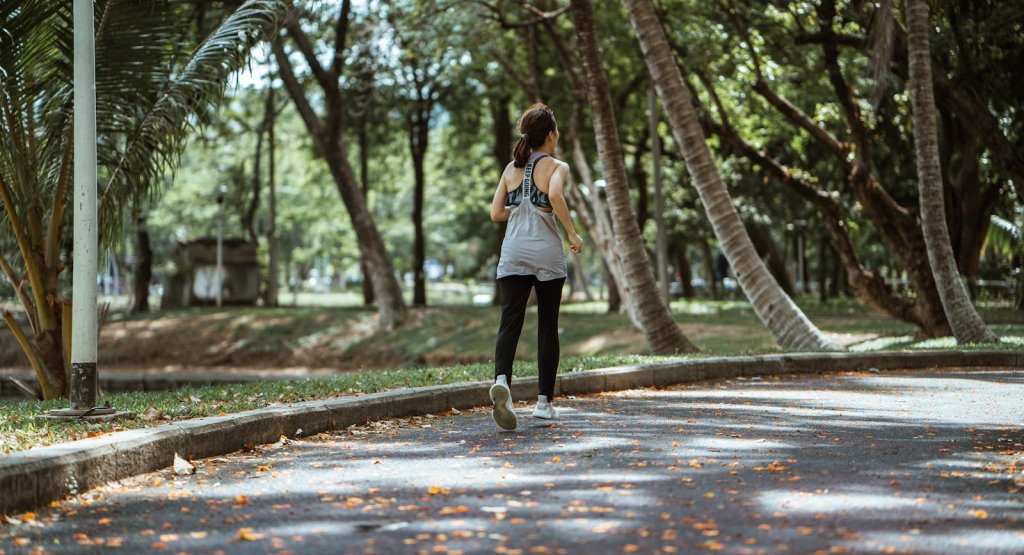
This guide delivers everything you need, including exercise breakdowns, up-to-date science, tips for every level, and a simple way to build your own cardio workouts at home.
- Choose from the 15 best moves below
- Mix and match for variety
- Follow science-backed routines
- Stay safe with the latest expert tips
- Get started anywhere, anytime
For detailed exercise demos and the latest health recommendations, always refer to the American Heart Association’s official fitness hub.
What Is Cardio? (And Why At-Home Cardio Works)
What Counts as Cardio Exercise?
Cardio is any activity that significantly raises your heart rate for an extended time, using large muscle groups and repetitive motion. You don’t need a treadmill or fancy equipment—just your bodyweight and a bit of space.
Examples: jumping, running, dancing, HIIT routines, stair climbing, or intense circuit workouts.
Why Do Cardio at Home?
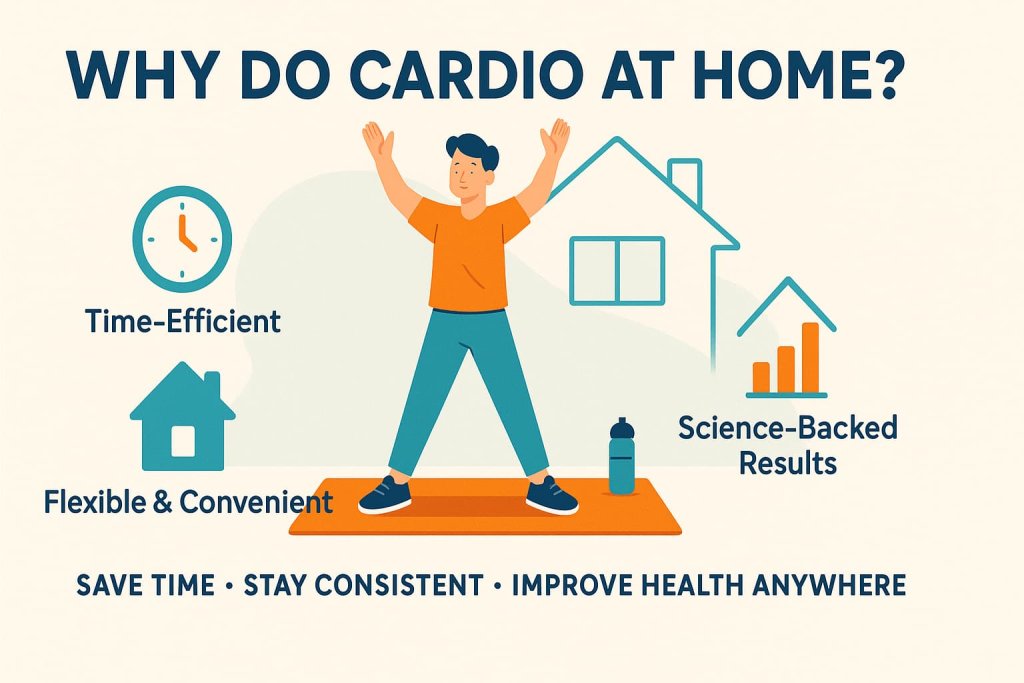
- Time-efficient: No commute, no equipment setup.
- Flexible: Squeeze in a quick 10-minute workout or a longer session, morning or night.
- Science-backed results: Home cardio is proven to lower blood pressure, improve cholesterol, reduce depression, and support weight control.
Health Guidelines & Stats
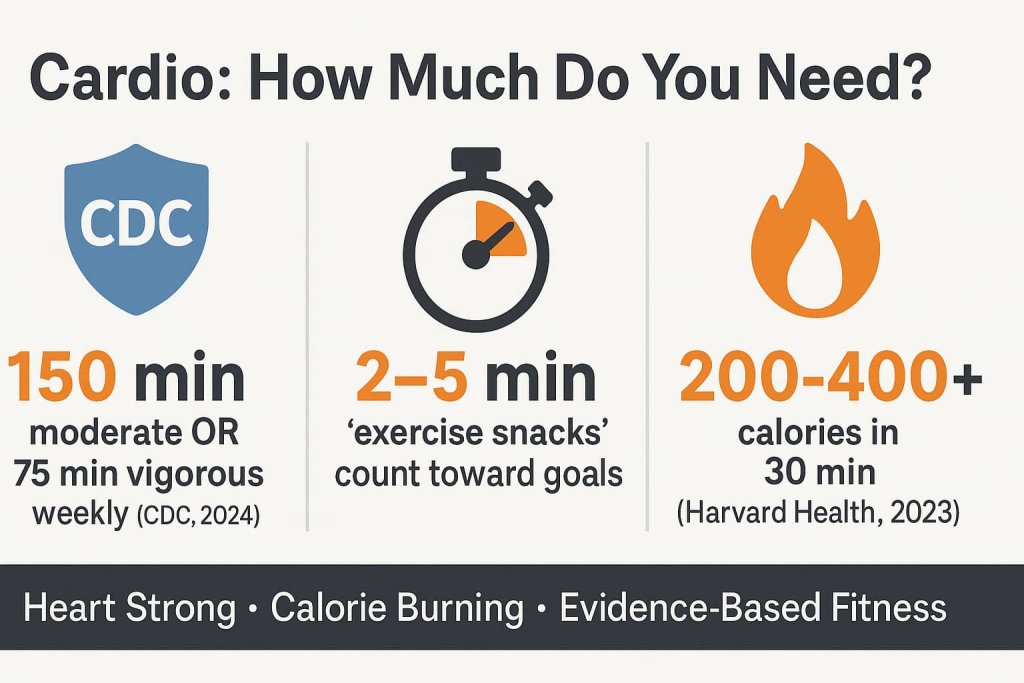
- The CDC recommends at least 150 minutes of moderate or 75 minutes of vigorous cardio weekly for adults (CDC, 2024).
- Studies confirm even “exercise snacks” of 2–5 minutes throughout the day can improve heart health if you reach your weekly activity goal.
- Cardio can burn 200–400+ calories in 30 minutes depending on body weight and intensity (Harvard Health, 2023).
The 15 Best Cardio Exercises to Do at Home
1. High Knees
How to Do It:
Jog in place, driving your knees up as high as possible toward your chest. Pump your arms to add momentum.
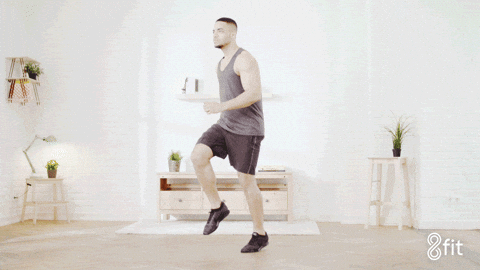
Why It Works:
High knees significantly increase heart rate and activate your abs, hip flexors, and lower body. This exercise is a staple in athletic warm-ups for a reason: it builds running speed, coordination, and cardiovascular fitness.
Pro Tip:
Go all out for 20–30 seconds, then rest or walk in place for 10–20 seconds. Repeat for multiple rounds as part of an interval circuit.
2. Jumping Jacks
How to Do It:
Jump feet out to the sides while raising your arms overhead, then return to the starting position with feet together and arms at your sides.
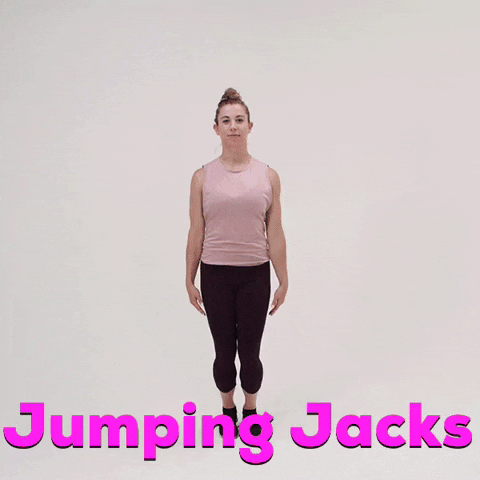
Why It Works:
Jumping jacks are a full-body exercise proven to raise your heart rate rapidly. They’re easy to modify for all levels.
Science Fact:
10 minutes of jumping jacks can burn about 100 calories for most adults (Healthline, 2024).
Source
3. Burpees
How to Do It:
Squat down, place hands on the floor, jump feet back to a plank, do a push-up (optional), jump feet forward, and explosively jump up.
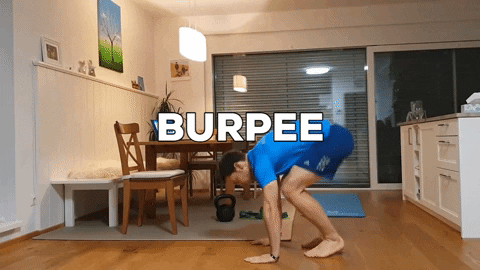
Why It Works:
Burpees combine cardio and strength—engaging chest, shoulders, quads, glutes, and core.
Science Fact:
Burpees are used in HIIT research for their high caloric burn and cardiovascular challenge.
4. Mountain Climbers
How to Do It:
From a plank position, quickly alternate driving your knees toward your chest. Keep hips low, core tight, and move at a brisk pace.

Why It Works:
Mountain climbers work the core, shoulders, and legs while spiking your heart rate.
You can slow down the movement to focus more on core engagement.
Trainer Tip:
Use mountain climbers as a warm-up or as a “finisher” to ramp up intensity at the end of a workout.
5. Squat Jumps
How to Do It:
Start in a deep squat. Swing arms and explode upward as high as you can. Land softly and immediately return to a squat.
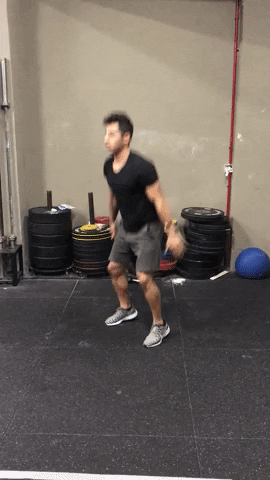
Why It Works:
Boosts lower body power, improves explosive strength, and is shown to burn more calories than regular squats.
Variation:
If jumps are too high impact, do “power squats” (rising onto toes) instead.
6. Speed Skaters
How to Do It:
Leap side to side, landing on one leg with the other leg sweeping behind. Swing your arms for balance.
Why It Works:
This lateral movement boosts balance, coordination, and heart rate. It also targets the glutes, outer thighs, and hips—muscles often missed in straight-line cardio.
Fun Fact:
Athletes use this for agility and injury prevention.
7. Step-Ups or Stair Running
How to Do It:
Use a sturdy chair, bench, or a set of stairs. Step up rapidly, alternating legs, driving the opposite knee up for extra intensity.

Why It Works:
Builds strength and cardio simultaneously. Step-ups activate quads, glutes, and calves.
Trainer Tip:
For an extra burn, add dumbbells or increase speed.
8. Jogging or Marching in Place
How to Do It:
Jog or march with arms swinging, lifting knees to hip height if possible.
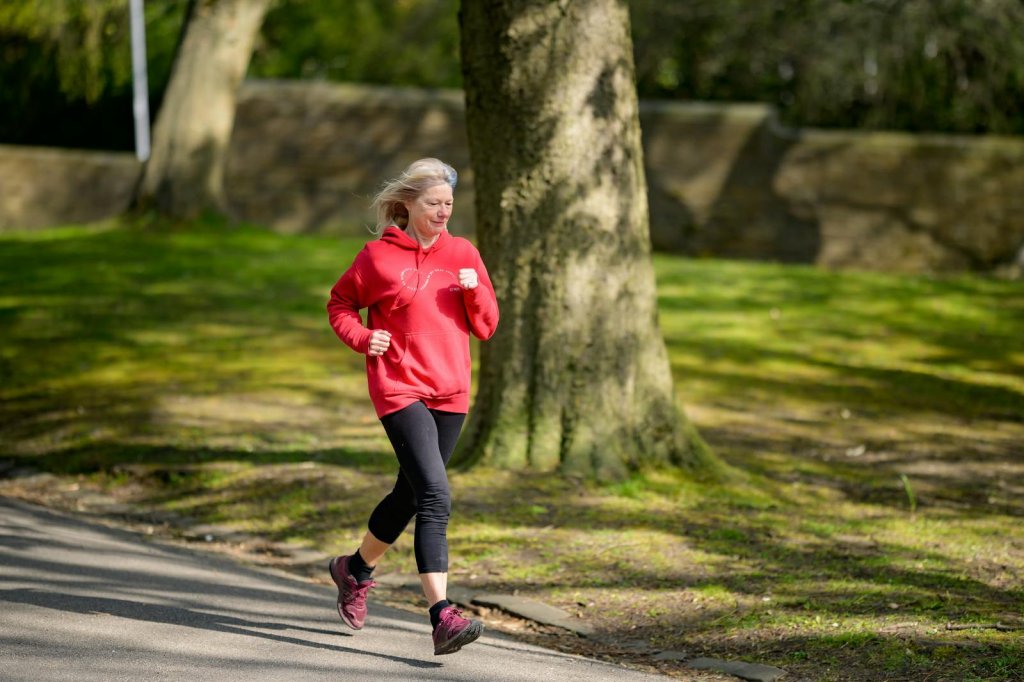
Why It Works:
A low-impact way to boost step count, increase daily NEAT (Non-Exercise Activity Thermogenesis), and gently elevate heart rate.
Variation:
Try “high knee marching” for extra core work or “butt kicks” for hamstring activation.
9. Dancing
How to Do It:
Move to your favorite music or follow a guided YouTube dance workout.
Why It Works:
Dance cardio is proven to elevate mood, reduce stress, and provide a fun, effective cardiovascular workout.
Science Fact:
Dancing is linked with reduced stress hormone (cortisol) levels and improved mental health (Harvard Health, 2023).
Source
10. Jump Rope (If Space Allows)
How to Do It:
Jump with both feet, alternate feet, or add tricks like double-unders as you advance.
Why It Works:
Jump rope burns up to 300 calories in 30 minutes and improves agility, coordination, and cardiovascular health (ACE Fitness, 2024).
Trainer Tip:
Try intervals: 30 seconds jumping, 15 seconds rest.
11. Jumping Lunges
How to Do It:
Start in a lunge, jump up and switch legs midair, landing in a lunge on the other side.
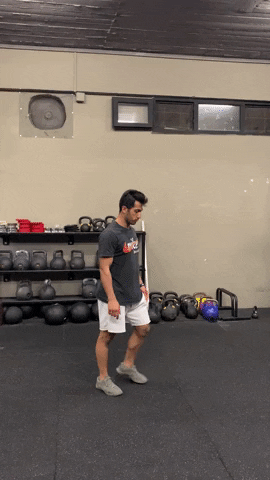
Why It Works:
Great for explosive leg strength, balance, and endurance.
If you’re new, try step-back lunges before progressing to jumps.
12. Plank Jacks
How to Do It:
From a plank, jump feet apart and together (like a jumping jack).
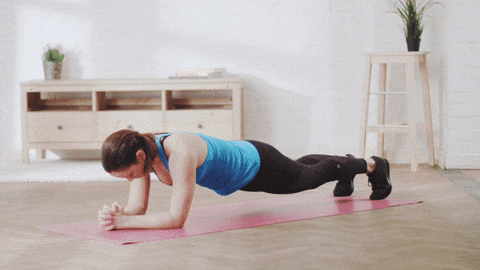
Why It Works:
Combines core activation with cardio. Engages shoulders, abs, and glutes.
Trainer Tip:
Keep your hips steady for maximum core engagement.
13. Butt Kicks
How to Do It:
Jog in place, kicking heels up to touch your glutes.
Why It Works:
Excellent for warming up hamstrings, boosting heart rate, and improving running mechanics.
Variation:
Try it at a slow or fast pace depending on your fitness level.
14. Pike-Ups or Toe Taps
How to Do It:
For pike-ups: from a plank, jump feet toward hands, then back.
For toe taps: Rapidly tap your toes on a raised surface.

Why It Works:
Boosts core and shoulder strength, enhances agility, and elevates heart rate quickly—great for small spaces.
15. Tabata or HIIT Circuits
How to Do It:
Choose 4–6 of the exercises above. Do each at full effort for 20–40 seconds, rest for 10–20 seconds, repeat for 4+ minutes.
Why It Works:
High-intensity interval training (HIIT) is shown to burn more fat, improve VO₂ max, and increase metabolic rate more efficiently than steady-state cardio (Wikipedia: HIIT, 2025).
Source
Quick Reference Table: Best At-Home Cardio Exercises
| Exercise | Main Focus | Impact Level | Equipment Needed |
|---|---|---|---|
| High Knees | Cardio, Abs | Medium | None |
| Jumping Jacks | Full Body, Cardio | Low/Medium | None |
| Burpees | Full Body, HIIT | High | None |
| Mountain Climbers | Cardio, Core | Medium/High | None |
| Squat Jumps | Legs, Power | High | None |
| Speed Skaters | Glutes, Cardio | Medium | None |
| Step-Ups | Legs, Cardio | Medium | Chair/Stairs |
| Jog in Place | Cardio, Low Impact | Low/Medium | None |
| Dancing | Cardio, Mood | Varies | Music/YouTube |
| Jump Rope | Cardio, Coordination | High | Jump Rope |
| Jumping Lunges | Legs, Power | High | None |
| Plank Jacks | Core, Cardio | Medium/High | None |
| Butt Kicks | Cardio, Hamstrings | Low/Medium | None |
| Pike-Ups/Toe Taps | Core, Cardio | Medium | Bench/Step |
| Tabata/HIIT | Full Body, Cardio | High | Timer, Mat |
Building Your Own Home Cardio Routine
Sample 20-Minute Cardio Circuit
| Exercise | Time |
|---|---|
| High Knees | 40 sec |
| Mountain Climbers | 40 sec |
| Jumping Jacks | 40 sec |
| Speed Skaters | 40 sec |
| Burpees | 40 sec |
| Rest | 20 sec |
| Repeat x4 | |
Warm-Up (5 mins): March in place, dynamic stretching
Cool Down (5 mins): Gentle stretching, deep breathing
Tips for Success
- Stay hydrated and wear supportive shoes.
- Mix high and low impact moves for joint safety.
- Listen to your body; scale back if new to exercise.
- Use a fitness app or timer to track intervals.
Science-Backed Cardio Training Tips
- Start slow if you’re new. Low-impact moves like marching, step-ups, or dancing are perfect for beginners.
- Progress intensity as you adapt—try plyometric (explosive) exercises for greater results.
- Mix up the moves: This prevents boredom and works more muscle groups.
- Interval structure: HIIT (short, high-intensity bursts) has been shown to improve cardiovascular health, insulin sensitivity, and fat loss more efficiently than longer steady-state cardio sessions.
- Hydrate and take breaks as needed.
- Track progress: Use a fitness tracker or journal to log your workouts and see improvement.
Safety Notes
If you have heart or joint issues, choose low-impact versions and consult your doctor before starting any new program.
Real-World Example: Home Cardio Success
Maria, age 34, lost 18 pounds in 4 months by combining 5 at-home cardio moves (high knees, squat jumps, mountain climbers, plank jacks, dancing) into 25-minute HIIT circuits, five times a week.
She tracked progress with her smartwatch, gradually increased intensity, and credits variety for keeping her motivated. Her resting heart rate dropped by 10 bpm, and her cholesterol improved (per her doctor’s advice).
FAQs About Home Cardio Workouts
How many days a week should I do home cardio?
Aim for at least 3–5 days/week, mixing moderate and vigorous intensity. The American Heart Association recommends at least 150 minutes total weekly.
Can I lose weight with at-home cardio only?
Yes! Combine regular cardio, healthy eating, and enough sleep for best results. Cardio burns calories and boosts metabolism—essential for fat loss.
What’s the best cardio for bad knees?
Low-impact options like step-ups, marching, dancing, and slow mountain climbers protect joints.
Can I build muscle with these routines?
Many moves (burpees, jump squats, mountain climbers) also build strength, but combine with bodyweight strength training for best muscle gains.
Should I do cardio before or after weights?
Either is effective; doing cardio after strength may improve fat loss and recovery.
Recent Policy Updates
- Short “exercise snacks” now officially count toward weekly cardio goals, per CDC, 2024.
- HIIT recommended as safe and highly effective for adults, including those with type 2 diabetes, based on new research.
Conclusion
The 15 best at-home cardio exercises are accessible, effective, and proven by science to support heart health, fat loss, and energy—all without a gym or equipment. Start with moves you enjoy, build consistency, and progress over time for lasting results.
